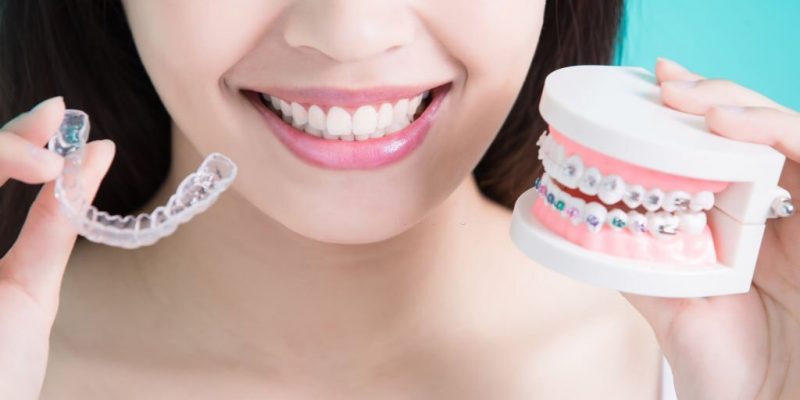Orthodontics is a branch of dentistry that can correct the misalignment of teeth and jaws (malocclusion). Common orthodontic treatments include braces, aligners, retainers, headgear, and more. Orthodontic procedures have elective and restorative benefits. They help improve the appearance of a person’s smile and teeth and correct improper and uneven bites.
The history of orthodontic devices dates back to 1000 BC. Greek and Etruscan materials reveal attempts to treat crowded, irregular, and protruding teeth using primitive yet impressively well-devised orthodontic appliances. Likewise, with the advent of braces – the most common orthodontic appliances – you can think of the times of Hippocrates and Aristotle (300 to 400 BC), when they considered several ways to straighten human teeth. Orthodontic dentistry has a rich past, and its future seems equally bright and fruitful. The onset of Invisalign dentist and other similar specialists has revolutionized orthodontic treatments.
Orthodontic Treatments: A Peak Into The Past
Although humankind and orthodontics have been intrinsically related since the beginning, modern orthodontic dentistry emerged in the 18th and 19th centuries. For example, people consider French dentist – Pierre Fauchard – the Father of Modern Orthodontics, whose book was– The Surgeon Dentist – which has been a ‘tour de force’ of the field. In 1819, Christophe Francois Delabree introduced the wire crib, which flagged off the inception of contemporary orthodontics. Likewise, Normal William Kingsley wrote the first article on orthodontics in 1858.
Finally, in the early 20th century, Edward Angle played a pivotal role in establishing orthodontics as a distinct domain of dentistry. He founded the first school and college of orthodontics. Kingsley also organized the American Society of Orthodontia in 1901, which we now as the American Association of Orthodontists (AAS). Since then, there has been looking back, and the field of Orthodontics has advanced by leaps and bounds. For example, Invisalign – the first clear aligner brand – hit the market in 1998 and transformed the face of cosmetic and restorative orthodontic treatments. But, we have elaborated on the past of orthodontics. What about the future? Let us find out!
Future Of Orthodontics And Invisalign: Three Trends To Look Forward To
To begin with, the future of orthodontics seems bright. More and more people, including adults, are now embracing orthodontic devices like braces and aligners. Thus, age no longer bars people from striving to achieve their best smile and teeth. Some of the future trends and patterns vis-à-vis orthodontics and Invisalign we can expect to see are –
-
Increasing Popularity of Invisalign and other Clear Aligners
Invisalign – the world’s most popular brand of clear aligners – burst into the scene in 1998. Since then, their popularity has only increased. The inconspicuous nature of clear aligners like Invisalign makes them an attractive option for adults, adolescents, and even children. In its 26 years of existence, Invisalign has treated mild to moderate orthodontic issues of 2.4 million patients. Currently, 80000 orthodontists from all over the globe get training and become Invisalign dentists, specializing in treating patients with the device.
When we talk about the future of Invisalign, it does seem bright. The unnoticeable nature of the device, coupled with comparative effectiveness, convenience, better predictable, and growing brand popularity in nooks and corners of the world, including in countries outside the USA and Europe, are indications that we can expect to see an inflation of Invisalign users worldwide.
-
Persistence of Traditional Braces
When deliberating on Invisalign, it is essential to note that it will be only effective for specific orthodontic issues. The best dentist Aubrey TX, still co-opts traditional metal braces to treat severe crowding or misaligned teeth. Braces are as essential and relevant to the world of orthodontics now as they were two decades ago. In fact, metal braces are the top recommendation for severe malocclusion. And they are also more successful in correcting such problems. Thus, one trend in the orthodontic domain is that traditional braces will continue to stand tall, irrespective of the purging popularity of invisible aligners.
-
Technological Advances
Another major trend regarding orthodontics is the surge in technological advancement. Now, we have an assortment of clear aligner brands, such as Byte, NewSmile, ClearCorrect, Candid, and more. Likewise, other novel innovations are inundating the field, some of which include –
- Itero Intraoral Scanners – They burst into the scene in 2007 to provide reliable and intuitive visualization capabilities for orthodontists and general dentists. As per the official website of Itero, the device was useful in 6 million restorative crowns, bridges, and custom implants.
- Dental Monitoring – Another latest innovation that can revolutionize the future of orthodontics is Dental Monitoring. It helps orthodontists track patients’ treatment progress in real-time from a remote location via a dedicated and secure online dashboard.
- SureSmile – It is a new technology that enables Invisalign dentists and other specialists to take digital scans of patients’ teeth to design and create custom wires. The technology helps dentists ensure that the braces move the teeth in a precise direction, thereby reducing the time spent using braces by as much as a third.
So, there we have a crisp overview of the future of orthodontics and Invisalign. Simply put, the future seems bright as we can expect traditional orthodontic devices and modern advancements to come together and help people from all walks of life.


